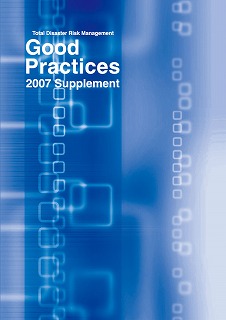Good Practices 2007

Foreword
In the past two decades, on average more than 200 million people have been affected every year by natural disasters. Even as for the grave natural disasters in last year, a mudslide triggered by heavy rains buried a whole village in the Philippine province of Southern Leyte on 17th of February 2006. Reportedly more than 200 people were killed in the slide with about 1,500 people missing. On 27th of May 2006 an M6.3 earthquake has struck the very highly populated region of Jogjakarta, Indonesia. The death toll reached 6,200 and the number of injured was 53,000. A strong undersea earthquake, which had a M 7.7, struck off the southern coast of Indonesia's Java island on 17th of July 2006, triggering a tsunami that swept away wooden buildings and killed at least 500 people. These crises triggered and brought about serious awareness for the necessity of regional solidarity and cooperation for disaster management.
Asian Disaster Reduction Center (ADRC) will not only continue to support the development of scientific capability against disasters, but will also pay increasing attention to the social dimensions of disaster prevention. ADRC has collaborative status with the United Nation Office for the Coordination of Humanitarian Affairs (UN-OCHA) Kobe and International Recovery Platform (IRP), and also works in collaboration with many stakeholders in Asia. ADRC and these partner organizations have formulated a holistic approach to disaster risk reduction known as Total Disaster Risk Management (TDRM).
“Total Disaster Risk Management: Good Practices” is a user-friendly handbook including the concept of TDRM and its good practices, that was published for UN World Conference on Disaster Reduction that was held on 18-22 January 2005 in Kobe, Japan. Herein “2007 Supplement of Good Practices” contains good practices submitted by ADRC member countries for relevant stakeholders to share knowledge in order to contribute to global disaster risk reduction.
Furthermore, it would be our great pleasure to continue receiving a broad range of good practices from you. I hope this publication will stimulate the promotion of the TDRM approach and contribute to efforts to build a safer world.
Contents
1 Armenia
Community-Based Capacity Building in Public Schools in Armenia
2. Japan
Voluntary Disaster Reduction Activities of Omisaki District (Kushimoto Town, Wakayama Prefecture)
3. Kazakhstan
Information for the "Good Skills" Journal Qostonay Fire Department
Wildfire Prevention and Countermeasures
4. Republic of Korea
One-Stop Service for Rapid and Easy Recovery Support
5. Kyrgyz
Kyrgyz Republic Ministry of Emergency Response
6. Singapore
7. Thailand
8. Viet Nam
More to lose - reducing family vulnerability to floods and storms in Central Vietnam

